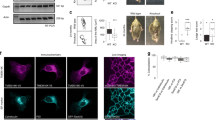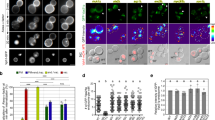Abstract
In genetic screens for new endocytosis genes in Caenorhabditis elegans we identified RME-1, a member of a conserved class of Eps15-homology (EH)-domain proteins. Here we show that RME-1 is associated with the periphery of endocytic organelles, which is consistent with a direct role in endocytic transport. Endocytic defects in rme-1 mutants indicate that the protein is likely to have a function in endocytic recycling. Evidence from studies of mammalian RME-1 also points to a function for RME-1 in recycling, specifically in the exit of membrane proteins from recycling endosomes. These studies show a conserved function in endocytic recycling for the RME-1 family of EH proteins.
This is a preview of subscription content, access via your institution
Access options
Subscribe to this journal
Receive 12 print issues and online access
$209.00 per year
only $17.42 per issue
Buy this article
- Purchase on Springer Link
- Instant access to full article PDF
Prices may be subject to local taxes which are calculated during checkout




Similar content being viewed by others
References
Mellman, I. Endocytosis and molecular sorting. Annu. Rev. Cell Dev. Biol. 12, 575–625 (1996).
Mukherjee, S., Ghosh, R. N. & Maxfield, F. R. Endocytosis. Physiol. Rev. 77, 759–803 (1997).
Grant, B. & Hirsh, D. Receptor-mediated endocytosis in the Caenorhabditis elegans oocyte. Mol. Biol. Cell 10, 4311–4326 (1999).
Guo, S. & Kemphues, K. J. par-1, a gene required for establishing polarity in C. elegans embryos, encodes a putative Ser/Thr kinase that is asymmetrically distributed. Cell 81, 611–620 (1995).
Montgomery, M. K., Xu, S. & Fire, A. RNA as a target of double-stranded RNA-mediated genetic interference in Caenorhabditis elegans. Proc. Natl Acad. Sci. USA 95, 15502–15507 (1998).
Fire, A. et al. Potent and specific genetic interference by double-stranded RNA in Caenorhabditis elegans. Nature 391, 806–811 (1998).
Mintz, L. et al. EHD1 — an EH-domain-containing protein with a specific expression pattern. Genomics 59, 66–76 (1999).
Pohl, U. et al. EHD2, EHD3, and EHD4 encode novel members of a highly conserved family of EH domain-containing proteins. Genomics 63, 255–262 (2000).
Saraste, M., Sibbald, P. R. & Wittinghofer, A. The P-loop — a common motif in ATP- and GTP-binding proteins. Trends Biochem. Sci. 15, 430–434 (1990).
Lupas, A. Prediction and analysis of coiled-coil structures. Methods Enzymol. 266, 513–525 (1996).
Santolini, E., Salcini, A. E., Kay, B. K., Yamabhai, M. & Di Fiore, P. P. The EH network. Exp. Cell Res. 253, 186–209 (1999).
Page, L. J., Sowerby, P. J., Lui, W. W. & Robinson, M. S. Gamma-synergin: an EH domain-containing protein that interacts with gamma-adaptin. J. Cell Biol. 146, 993–1004 (1999).
Haider, N. B. et al. Evaluation and molecular characterization of EHD1, a candidate gene for Bardet-Biedl syndrome 1 (BBS1). Gene 240, 227–232 (1999).
Clokey, G. V. & Jacobson, L. A. The autofluorescent “lipofuscin granules” in the intestinal cells of Caenorhabditis elegans are secondary lysosomes. Mech. Ageing Dev. 35, 79–94 (1986).
Kostich, M., Fire, A. & Fambrough, D. M. Identification and molecular-genetic characterization of a LAMP/CD68-like protein from Caenorhabditis elegans. J. Cell Sci. 113, 2595–2606 (2000).
Fares, H. & Greenwald, I. Regulation of endocytosis by CUP-5, the Caenorhabditis elegans mucolipin-1 homolog. Nature Genet. 28, 64–68 (2001).
Vida, T. A. & Emr, S. D. A new vital stain for visualizing vacuolar membrane dynamics and endocytosis in yeast. J. Cell Biol. 128, 779–792 (1995).
Besterman, J. M., Airhart, J. A., Woodworth, R. C. & Low, R. B. Exocytosis of pinocytosed fluid in cultured cells: kinetic evidence for rapid turnover and compartmentation. J. Cell Biol. 91, 716–727 (1981).
Bomsel, M., Prydz, K., Parton, R. G., Gruenberg, J. & Simons, K. Endocytosis in filter-grown Madin–Darby canine kidney cells. J. Cell Biol. 109, 3243–3258 (1989).
Gagescu, R. et al. The recycling endosome of Madin–Darby canine kidney cells is a mildly acidic compartment rich in raft components. Mol. Biol. Cell 11, 2775–2791 (2000).
Clark, S. G., Shurland, D. L., Meyerowitz, E. M., Bargmann, C. I. & van der Bliek, A. M. A dynamin GTPase mutation causes a rapid and reversible temperature-inducible locomotion defect in C. elegans. Proc. Natl Acad. Sci. USA 94, 10438–10443 (1997).
Apodaca, G., Enrich, C. & Mostov, K. E. The calmodulin antagonist, W-13, alters transcytosis, recycling, and the morphology of the endocytic pathway in Madin–Darby canine kidney cells. J. Biol. Chem. 269, 19005–19013 (1994).
van Weert, A. W., Geuze, H. J., Groothuis, B. & Stoorvogel, W. Primaquine interferes with membrane recycling from endosomes to the plasma membrane through a direct interaction with endosomes which does not involve neutralisation of endosomal pH nor osmotic swelling of endosomes. Eur. J. Cell Biol. 79, 394–399 (2000).
Lin, S. X., Grant B., Hirsh D. & Maxfield F. R. . Rme-1 regulates the distribution and function of the endocytic recycling compartment in mammalian cells. Nature Cell Biol. 3, XX (2001).
Brenner, S. The genetics of Caenorhabditis elegans. Genetics 77, 71–94 (1974).
Williams, B. D. Genetic mapping with polymorphic sequence-tagged sites. Methods Cell Biol. 48, 81–96 (1995).
Grant, B. & Greenwald, I. Structure, function, and expression of SEL-1, a negative regulator of LIN-12 and GLP-1 in C. elegans. Development 124, 637–644 (1997).
Rosenbluth, R. E., Cuddeford, C. & Baillie, D. L. Mutagenesis in Caenorhabditis elegans. II. A spectrum of mutational events induced with 1500 r of gamma-radiation. Genetics 109, 493–511 (1985).
Gu, J., Stephenson, C. G. & Iadarola, M. J. Recombinant proteins attached to a nickel-NTA column: Use in affinity purification of antibodies. Biotechniques 17, 257–262 (1994).
Bettinger, J. C., Lee, K. & Rougvie, A. E. Stage-specific accumulation of the terminal differentiation factor LIN-29 during Caenorhabditis elegans development. Development 122, 2517–2527 (1996).
Hall, D. H. et al. Ultrastructural features of the adult hermaphrodite gonad of Caenorhabditis elegans: relations between the germ line and soma. Dev. Biol. 212, 101–123 (1999).
Fire, A. Integrative transformation of Caenorhabditis elegans. EMBO J. 5, 2673–2680 (1986).
Mello, C. C., Kramer, J. M., Stinchcomb, D. & Ambros, V. Efficient gene transfer in C. elegans: extrachromosomal maintenance and integration of transforming sequences. EMBO J. 10, 3959–3970 (1991).
Acknowledgements
We thank L. Pedraza and W. Pryzlecki for technical assistance; H. Fares, V. Irikura, Y. Kohara, X. Li and A. Melendez for reagents and strains; and Q. Al-Aqwati, H. Fares, I. Greenwald, F. Maxfield and H. Wilkinson for discussions during this work and for comments on this manuscript. We also thank H. Fares and I. Greenwald for the gift of rme-1 mutant strains. Many of the strains used in this work were provided by the Caenorhabditis Genetics Center. This work was supported by a grant from NIH to D.H.H., by a NIH National Service Research Award to B.G. and by a March of Dimes Grant to D.H.
Author information
Authors and Affiliations
Corresponding author
Rights and permissions
About this article
Cite this article
Grant, B., Zhang, Y., Paupard, MC. et al. Evidence that RME-1, a conserved C. elegans EH-domain protein, functions in endocytic recycling. Nat Cell Biol 3, 573–579 (2001). https://doi.org/10.1038/35078549
Received:
Revised:
Accepted:
Published:
Issue Date:
DOI: https://doi.org/10.1038/35078549
This article is cited by
-
FERARI is required for Rab11-dependent endocytic recycling
Nature Cell Biology (2020)
-
To degrade or not to degrade: mechanisms and significance of endocytic recycling
Nature Reviews Molecular Cell Biology (2018)
-
ATP-dependent membrane remodeling links EHD1 functions to endocytic recycling
Nature Communications (2018)
-
Endocytic recycling protein EHD1 regulates primary cilia morphogenesis and SHH signaling during neural tube development
Scientific Reports (2016)
-
An autonomous DNA nanomachine maps spatiotemporal pH changes in a multicellular living organism
Nature Communications (2011)



